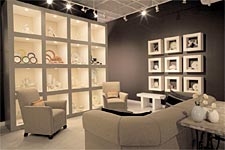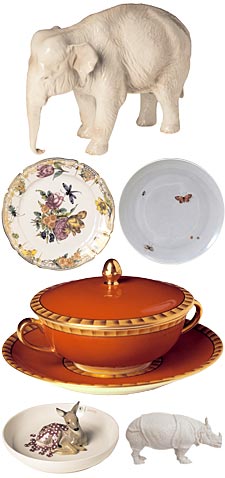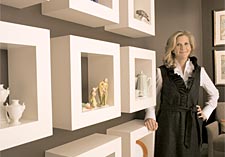by Gina Bazer
 |
| When it opens in February, the Nymphenburg U.S.A. show room will sit inside Au Coin du Feu, 470 North Milwaukee Avenue, 312-421-3500 |
NYMPHENBURG, the famous German porcelain company, hadn’t even opened its first stateside show room when the calls started pouring in. A California collector wanted to schedule a visit that afternoon; a Wisconsin woman needed a missing piece for the tea set her father brought back from Germany in 1946; and a New York customer required a highly coveted rhinoceros figure, ASAP. The first two requests were a breeze (the 260-year-old manufacturer can custom-match any of its pieces, no matter how old), but the latter required quick thinking on the part of Nymphenburg U.S.A.’s new president, Mary Jeanne Reese.
“I had to sell him mine,” Reese admitted, a little shaken, as if an old friend had unexpectedly moved away. Soon enough, she’d have another rhinoceros-at the end of February, she opens Nymphenburg’s only show room outside of Germany inside her West Loop fireplace company, Au Coin du Feu. Still, one could hardly fault her distress. Once you’ve been touched by the world’s most revered “white gold,” as Reese was in the 1990s while living in Germany near the Nymphenburg Castle, it becomes a hard habit to break.
 |
| Some iconic Nymphenburg pieces, from top: Painted porcelain elephant from 1916; Cumberland plate circa 1760 beside a new rendition from 2000 by contemporary designer Ted Muehling; a cream soup cup, lid, and saucer from the 1950s; designer Hella Jongerius’s porcelain bowl with fawn; the popular rhinoceros figurine that sits on Nate Berkus’s shelf. |
Just ask Murray Moss, arguably the country’s most influential promoter of design. Until seven years ago, he’d been a devout modernist, carrying mostly contemporary Italian furniture and functional objects at his SoHo show room, Moss. That changed after he went to Germany and toured the Nymphenburg Castle, where craftspeople still make everything from animal figurines to dishes by hand. “When I saw these beautiful, realistic figures that served absolutely no function but to simply delight, I was amazed,” he says. “Everything at Moss at that time had been so heavily focused on geometry and simplicity, on function, not on decoration, and I realized this is what I’d been missing. Suddenly, I felt freedom. I realized that if these 18th-century pieces moved me-if they felt relevant to me now, today-then they were contemporary. It was like my ideology had completely changed.” A year later, Moss held a Nymphenburg exhibition at his show room that shocked his fellow modernists; his clients, however, ate it up, and now his store is a place where 18th-century French busts are sold alongside postmodern chairs made of stuffed animals.
Interior decorator Nate Berkus, who designed Chicago’s new Nymphenburg show room (and has his own rhino on a bookshelf in his Manhattan apartment), attributes this renewed interest among design lovers in objects that have history to a hunger for the old. “There’s a lot of great new stuff out there,” he says, “but it’s the old things that present an opportunity to educate yourself.”
Still, even with the blessings of the tastemakers, traditional patterns are not for everyone. Nymphenburg’s biggest coup has been recruiting contemporary artists, like jewelry designer Ted Muehling (a favorite of fashion icons like Kate Spade) and the highly regarded Dutch designer Hella Jongerius. Muehling’s bisque bird was inspired by a scientifically accurate series popular in the early 1900s; he modernized it by leaving the figure unpainted and unglazed. Jongerius’s designs include plates with attached figures of lounging animals, such as a hippopotamus blanketed in flowers.
 |
| Nymphenburg U.S.A.’s Mary Jeanne Reese |
Reese used just such a plate to serve crackers at a recent dinner party, much to the delight of her guests. The proud owner of a complete set of Nymphenburg dinnerware and a full tea service (her passion for the porcelain helped her land the job as head of U.S. operations), she hopes to purchase the dishwasher-safe Perl pattern soon, to use every day. “I love using it-it’s one of those little things that make my day,” she says, then adds: “I curate my surroundings. Life is too short not to.”
Photography: Grant Kessler (muehling plate and rhinoceros courtesy of Nymphenburg U.S.A.)


